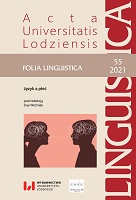Kim były szesnastowieczne malarki, murarki imydlarki?
Who were the 16th century malarka (she-painter), murarka (she-mason) and mydlarka (she-soaper)?
Author(s): Anetta Luto-KamińskaSubject(s): Gender Studies, Lexis, Historical Linguistics, Western Slavic Languages, 16th Century
Published by: Wydawnictwo Uniwersytetu Łódzkiego
Keywords: history of Polish language - 16th century; historical word formation; female names (feminatives); names of the professions;
Summary/Abstract: The article describes difficulties connected with interpreting 16th century names of women created out of men’s profession names. The analyzed lexical material was limited to feminine formations created with the use of the -ka suffix out of masculine names ending with -arz. Due to such a clear formal restriction, I analyzed all feminatives in this class found in SPXVI as well as additional occurrences excerpted by me, which constituted over 60% of textual usages analyzed herein. I focused on two functions of the -ka suffix creating nomina feminativa of the time – the names of wives and the “simple” feminatives, that is those in which the formant provides the formative base only with the meaning of femininity. Over 60 lexemes were analyzed. In the first place, I examined all registered appearances of every word in Renaissance texts, with a particular emphasis of uses in non-literary sources providing authentic historical data about the people described. I confronted thus obtained information with 1) the findings of historians, demographics scholars or sociologists researching the role of women in Renaissance society and the opportunities available for women regarding taking up paid work and performing specific professions; 2) lexicographic descriptions of particular entries in SPXVI, broadening lexicographic analysis with the earlier lexis as registered in SStp and the later lexis found in source dictionary (Cn). The final stage of research involved a formal historical word formation analysis of the described feminatives and its dependencies with lexicographic descriptions of particular items.
Journal: Acta Universitatis Lodziensis. Folia Linguistica
- Issue Year: 2021
- Issue No: 55
- Page Range: 11-35
- Page Count: 25
- Language: Polish

